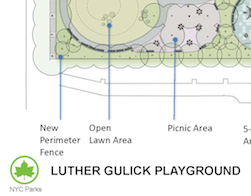Below are the notes, taken by Karen Overton of Partnerships for Parks, from our first ever event–an in-park listening session.
Notes from Luther Gulick Park Listening Session (6/4/09)
Approximately 75 people attended the meeting which was held in the park from 7-8pm. Local representatives came from Community Board 3, Councilmember Alan Gerson’s office, State Assembly Speaker Sheldon Silver’s office, and State Senator Daniel Squadron’s office. Four NYC Department of Parks and Recreation staff attended. Residents came from the neighborhood.
The meeting opened with a welcome from David Bolotsky, organizer of the Friends of Luther Gulick Park, followed by a brief history of the Luther Gulick Park by Bob Redmond, Director of Capital Projects from the Parks Department, and an introduction of Mike McClean, Park Manager, Richard Ropiak CB3 Chair of the Parks Committee, and Karen Overton, Partnerships for Parks and note-taker. A megaphone was passed around to any resident who wanted to speak about what they envisioned for the park.
The following notes are arranged by themes, due to the large number of comments made during the evening.
Communications: One of the first comments addressed a complaint about outreach. It was noted that no one was meant to be excluded, flyers were posted in the neighborhood in English, Spanish and Chinese, and that additional meetings could be arranged. Hillman Housing offered a community meeting space for future gatherings. Residents were asked to sign a sheet to be put on an email list, and to join the Community Board 3 Parks Committee mailing list in order to be sent future notices. The listening session is the first of many steps that need to be taken in order to renovate the park. Therefore, other opportunities will be available to include those unaware of the meeting or unable to attend.
Greening the Park: The majority of speakers expressed a desire for greening the park. People would like to see hedges, grassy lawn for play, flower beds, vegetable gardens, and the return of the many trees which were removed due to Asian Longhorn Beetle infestation. Several people noted how hot the park becomes without leaves to shade them, and how a grove of trees blocking the bridge might act as a sound buffer. In response, it was noted that:
Grass does not hold up well in urban parks so that these areas preclude active sports or a decision to install artificial turf must be taken;
Trees are in high demand and cost $2,000 each. Varieties are selected by a Parks forestry specialist and the decision is based on the species ability to survive in the particular urban landscape. Transplanting trees is very stressful, and Parks highly recommended waiting for the completion of capital improvements to plant the trees in order to avoid killing a few in the process of transplanting.
Access: Many people wanted the dividing fence between the playground and park removed, although the point was made that parents typically request a single entrance to a park catering to small children. There were also suggestions for: installing a fence along the western edge of the park and for the upgrade to beautiful wrought iron fencing; A gate to lock the park, helping with enforcement of park rules (primarily noise reduction late at night), and; obtain an easement from Hillman Housing to enter from the south side of the park.
Bathrooms: Several people noted the need for a comfort station, and asked for a temporary port-o-john. In response, it was noted that Parks does not bring in temporary solutions, as experience has shown that people vandalize and abuse the service.
Enforcement: Several people noted that enforcement of park regulations was not happening. Barbeques, noise, litter and people failing to pick up after their dog were the most common infractions. Signage and fencing were requested as solutions. Parks suggested that the Friends of Luther Gulick Park meet with the local NYPD precinct to discuss enforcement issues.
Barbeques: There were many different viewpoints on this activity. Those in favor, felt it was family-friendly and that this park space made up for the loss of bbq area in East River Park. Those against, felt it brought noise and litter to the park, and that it represented a fire hazard. Parks clarified that bbqs were not sanctioned in this park.
Sound Barrier: Many people shared how noisy the traffic from the Williamsburg Bridge is. They brought up ideas for planting trees in groves or installing non-organic sound barrier buffers. It was noted that Department of Transportation may also be able to address this issue.
Usage: Recommendations about the various uses of the park included: upgrade the handball courts; install tables and benches; creation of a water feature; creation of a circular feature that could have multiple purposes (i.e. ice skating in the winter, wading pond in the summer); include new recreational amenities like sand pit for volleyball court & ping pong tables; add composting and recycling bins.
Water: One person noted that the sprinkler system comes on in the middle of the night and might be broken. Someone else asked that a water source for the new greenery be well planned out.
Design Issues: Many people commented that the park should feel like one space, rather than be broken into unrelated and disconnected spaces. One person asked that Parks go above and beyond the ADA design requirements to insure that the needs of the elderly and physically challenged are met. Another person asked that the relationship between this park and East River Park be considered. Another person suggested that the elements requiring concrete surfaces (i.e. basketball) be moved to the outside of the park and the greenery located at the center.
Dogs: One person inquired about the consideration of a dog run for the park.
Funding: Parks estimates that a capital improvement will cost $2,000,000. Sources of funding are the NYC Council, Manhattan Borough Presidents Office, and NYS Assembly. Public-private partnerships are also effective at raising the money for improvements and on-going maintenance.
Timeline for Capital Improvement: Once funding has been secured, Parks will go through a design process (including the solicitation of community input at various stages) and implement the project. This typically takes 2 years.

